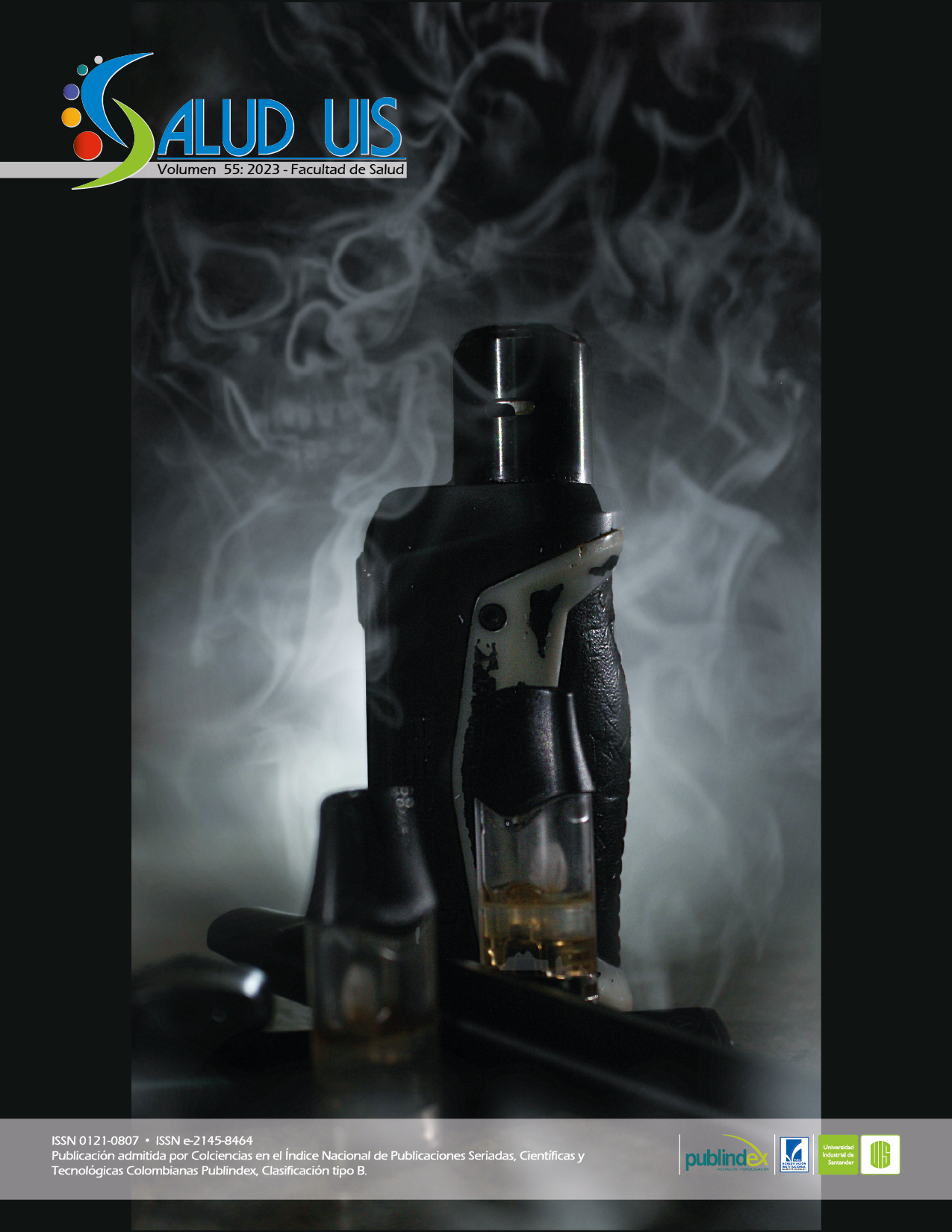Abstract
Introduction: The sick building syndrome has been described as a health condition suffered by workers due to
physical, chemical, biological, and psychosocial risk factors of the work environment. Its origin is multifactorial and
symptoms disappear when the worker leaves the building. In Colombia there is not an instrument for its diagnosis. Objective: To determine the presence of the sick building syndrome and identify the associated factors in the facilities of an institution providing health services. Methods: The survey of the Technical Prevention Standard 290 (National Institute of Safety and Hygiene at Work, attached to the Ministry of Labor and Social Affairs of Spain) was applied to 70 administrative workers. Results: The results demonstrated the presence of the sick building syndrome, and back pain was identified as the most prevalent symptom. According to the statistical analysis, the associated risk factors were physical and multiple psychosocial factors related to the organization, therefore, strengthening this aspect is suggested. Conclusions: Unlike similar studies, the percentage of the presence of respiratory, eye and allergy-related symptoms was less than 20%, which could be explained by the biosafety and isolation conditions due to the COVID-19 mitigation program therefore; it is advisable to continue maintaining these conditions and carry out a more in-depth study on the origin of the outstanding symptoms.
References
Jansz J. Sick Building Syndrome. En: Quah SR. International Encyclopedia of Public Health. 2da Edición. Cambridge (MA): Academic Press; 2017. p. 502-505. https://doi.org/10.1016/B978-0-12-803678-5.00407-0
Ruiz L, García MP. Calidad del Ambiente Interior [Internet]. Madrid: Centro Nacional de Nuevas Tecnologías, Instituto Nacional de Seguridad e Higiene en el Trabajo; 2022. [Consultado 19 Abr 2022]. Disponible en: https://www.insst.es/documents/94886/509319/
CalidadambinteriorDTECAI.pdf/6f7cfa1c-215d4f56-9e39-2869a23d8892 3. Rey-Martínez FJ, Ceña Callejo R. Edificios saludables para trabajadores sanos, calidad de ambientes interiores. 1ra Edición. Valladolid: Junta Castilla y León, Consejería de Ergonomía y Empleo; 2006. Disponible en: https://www.fessegovia.es/wpcontent/uploads/2018/09/Edificios-saludables.pdf
Berenguer MJ, Guardino Solá X, Hernández Calleja A, Martí Solé MC, Nogareda Cuixart C, Solé Gómez MD. El síndrome del edificio enfermo. Madrid: Instituto Nacional de seguridad e Higiene en el Trabajo; 1994. 140 p. Disponible en: https://www.prevencionintegral.com/en/node/33450
Boldú J, Pascal I. Enfermedades relacionadas con los edificios. An Sist Sanit. 2005; 28 (Supl. 1): 117-121.
Berenguer MJ. NTP 289: Síndrome del edificio enfermo: factores de riesgo [Internet]. Madrid: Ministerio de Trabajo y Asuntos sociales, Instituto Nacional de Seguridad e Higiene en el Trabajo; 1991. [Consultado 19 Abr 2022]. Disponible en: https://www.insst.es/documents/94886/327166/ntp_289.pdf/7299d03d-aba7-4b06-8adb-5d5732fb5eb9
Daza MÁ, Martínez DX, Caro-Hernández PA. contaminación microbiológica del aire al interior y el síndrome del edificio enfermo. Biociencias. 2015; 10(2): 37–50. https://doi.org/10.18041/2390-0512/bioc..2.2641
Piñeda A, Montes G. Ergonomía ambiental: iluminación y confort térmico en trabajadores de oficinas con pantalla de visualización de datos. RIMCI [Internet]. 2014; 1(2): 49–71 [Consultado 19 Abr 2022].
Lu CY, Tsai MC, Muo CH, Kuo YH, Sung FC, Wu CC. Personal, psychosocial and environmental factors related to sick building syndrome in official employees of Taiwan. Int J Environ Res Public Health. 2017; 15(1): 7. doi: https://doi.org/10.3390/ijerph15010007
Solé MD, Pérez N J. NTP 290: El síndrome del edificio enfermo: cuestionario para su detección. Madrid: Instituto Nacional de Seguridad e Higiene en el Trabajo. Centro Nacional de Condiciones de Trabajo; 1991. 7 p. [Consultado 19 Abr 2022]. Disponible en: http://www.insht.es/InshtWeb/Contenidos/Documentacion/FichasTecnicas/NTP/Ficheros/201a300/ntp_290.pdf
Celik S, Celik K, Dirimese E, Taşdemir N, Arik T, Büyükkara İ. Determination of pain in musculoskeletal system reported by office workers and the pain risk factors. Int J Occup Med Environ Health. 2018; 31(1): 91-111. http://doi.org/10.13075/ijomeh.1896.00901
Citko A, Górski S, Marcinowicz L, Górska A. sedentary lifestyle and nonspecific low back pain in medical personnel in North-East Poland. Biomed Res Int. 2018; 2018: 1965807. doi: http://doi.org/10.1155/2018/1965807
Freimann T, Pääsuke M, Merisalu E. Work-related psychosocial factors and mental health problems associated with musculoskeletal pain in nurses: A cross-sectional study. Pain Res Manag. 2016; 2016: 9361016. doi: http://doi.org/10.1155/2016/9361016
Kim JY, Shin JS, Lim MS, Choi HG, Kim SK, Kang HT, et al. Relationship between simultaneous exposure to ergonomic risk factors and work-related lower back pain: a cross-sectional study based on the fourth Korean working conditions survey. Ann Occup Environ Med. 2018; 30(1): 58. http://doi.org/10.1186/s40557-018-0269-1
Rodríguez DC, Dimate AE. Evaluación de riesgo biomecánico y percepción de desórdenes músculo esqueléticos en administrativos de una universidad Bogotá (Colombia). Rev Inv Andina [Internet]. 2014; 17(31): 1284-1299. doi: 10.33132/01248146.541
Zwart BC, Broersen JP, Frings-Dresen MH, van Dijk FJ. Musculoskeletal complaints in The Netherlands in relation to age, gender and physically demanding work. Int Arch Occup Environ Health. 1997; 70(5): 352-360. doi: http://doi.org/10.1007/s004200050229
Park J, Kim Y. Association of exposure to a combination of ergonomic risk factors with musculoskeletal symptoms in Korean workers. Int J Environ Res Public Health. 2020; 17(24): 9456. doi: https://doi.org/10.3390/ijerph17249456
Artazcoz L, Cortès I, Moncada S, Brotons ME. Diferencias de género en los factores asociados al dolor de espalda crónico en trabajadores. Arch Prev Riesgos Labor. 1999; 2(1): 11–18
Castillo M JA, Ramírez C BA. El análisis multifactorial del trabajo estático y repetitivo. Estudio del trabajo en actividades de servicio. Rev Cienc Salud. 2009; 7(1): 65–82.
García Delgado JÁ, Valdés Lara G, Martínez Torres J del C, Morales IP. Epidemiología del dolor de espalda bajo. Invest Medicoquir. 2014; 6(1):112–125.
Miró E, Solanes A, Martínez P, Sánchez AI, Rodríguez Marín J. Relación entre el Burnout o «síndrome de quemarse por el trabajo», la tensión laboral y las características del sueño. Psicothema. 2007; 19(3): 388–394.
World Health Organization and Pan American Health Organization. Influenza report WE 36. Washington D. C: PAHO; 2020 [Consultado 19 Abr 2022].
Ranasinghe P, Wathurapatha WS, Perera YS, Lamabadusuriya DA, Kulatunga S, Jayawardana N, et al. Computer vision syndrome among computer office workers in a developing country: An evaluation of prevalence and risk factors. BMC Res Notes. 2016; 9:150. doi: 10.1186/s13104-016-1962-1
Chlasta-Twardzik E, Górecka-Nitoń A, Nowińska A, Wylęgała E. The Influence of Work Environment Factors on the Ocular Surface in a One-Year FollowUp Prospective Clinical Study. Diagnostics. 2021; 11(3): 392. doi: 10.3390/diagnostics11030392

This work is licensed under a Creative Commons Attribution 4.0 International License.
Copyright (c) 2023 Paola Andrea Caro-Hernandez, Claudia Alejandra González-Gallego, Edward Fabián Carrillo-Borda
